In the “shadow” of the Black Moon
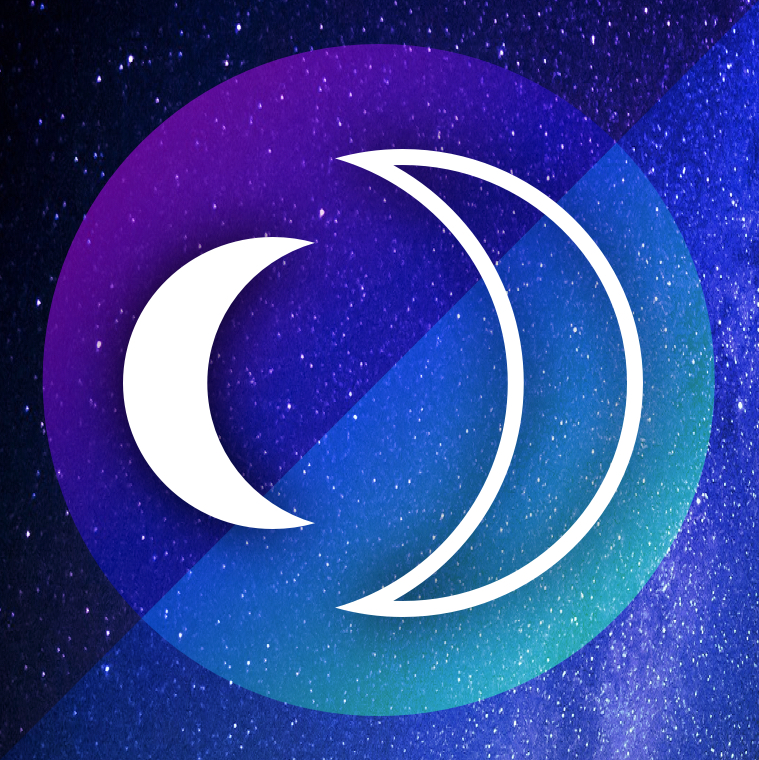
The Black Moon, also popularised as Lilith, points at mysterious, remote and hidden parts of human psyche that belong to the domain of unconscious, the Jungian “shadow”. This doesn’t mean that those personal traits lie dormant, quite the opposite, the Black Moon holds the keys to our alter ego that is always active behind the scenes.
The Black Moon is perhaps the most recent “serious” addition to the astrological knowledge that actually stood the test of time. Astrology is notorious for its never ending stream of techniques and ideas most of them — no matter how popular during their time — don’t stick around for longer than a few decades and eventually get dissolved by the flow of time.
Not so with the Black Moon! Since the time of its discovery the Black Moon has solidified its presence in the astrological knowledge perhaps due to the two facts: its unique symbolism and solid astronomical reality that objectifies its existence and brings it into our awareness.
Astrological appearance of the Black Moon has coincided with the era of scientific inquiry into human psyche. The period of 1870–1940 witnessed the emergence of psychoanalysis techniques of Sigmund Freud and novel concepts of analytical psychology pioneered by Carl Jung. Those new methods became the foundation for a wide variety of techniques and modalities of psychological and therapeutic practices.
Jungian psychology is of especial interest since its concept of “shadow” — the repressed, suppressed or disowned qualities of the conscious self — is closely related to the astrological nature and symbolism of the Black Moon.
Discovery of the Black Moon
The idea of the Black Moon was introduced by French astrologer Dom Neroman who studied the nature of the Lunar Apogee around 1930s. Dom Neroman was a prolific astrological researcher who used scientific methods with the goal to further progress astrology and dispel its superstitious image by revealing deeper cosmic truths and principles behind this discipline.
His other prominent discoveries include astrogeography and the heptagrams that we discussed in the story called “Finding dominant planet using Heptagrams”.
Defining the Black Moon
According to Kepler’s laws of orbital movement, all celestial bodies like planets and asteroids don’t move in perfectly circular orbits — they actually travel along elliptical orbits. Contrary to the circle that has a single centre point, the ellipse has two centres that are called focuses (or foci for more Latin inclined readers).
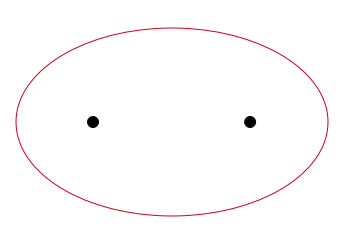
This how an elliptical orbit is usually illustrated using a highly eccentric ellipse (in this case showing ~0.8 eccentricity). This kind of elongated orbit is common to comets and asteroids. Orbits of major planets like Mercury, Venus, Mars, Jupiter and Saturn around the Sun are much closer to a circular shape.
Adding the main larger planet (the Earth) and its orbiting satellite (the Moon) can be visualised like illustrated below.
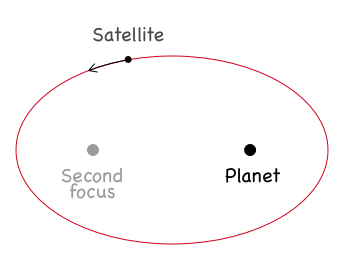
In reality, the Moon orbit eccentricity is much lower, only ~0.05, and is not possible to illustrate on a small computer screen: it’ll look like a circle. For the sake of simplicity we’ll be using an ellipse with 0.23 eccentricity, just enough to convey the idea of a non-circular orbit.
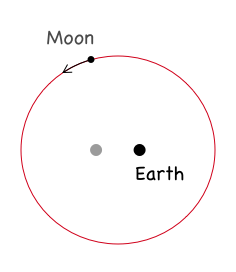
The Moon is travelling around the Earth along such an elliptic orbit with two focal points: one occupied by the Earth and another invisible second point that is located about 42,500 kilometres away from the Earth’s centre.

The illustration below shows that — as seen from the Earth — the second empty focus actually overlaps with the location of the Lunar Apogee, the furthest position of the Moon from Earth. More precisely, both the Lunar Apogee and the Black Moon have equal ecliptic longitude and therefore share same Zodiacal position. The Apogee is behind and much further than the Black Moon.
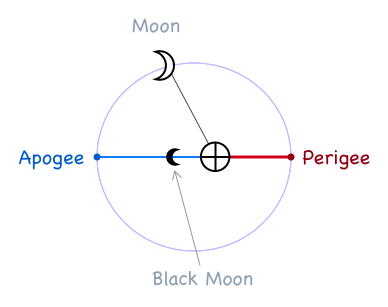
As the result of his astrological exploration into the nature and significance of the Lunar Apogee Dom Neroman introduced the term Black Moon to describe the second empty focus of the lunar orbit.
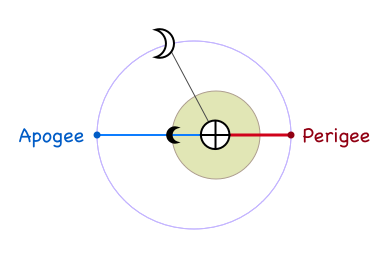
Unlike the Moon, the second focus (or the Black Moon) moves in a perfectly circular orbit around the Earth and completes each orbit in slightly under 9 years.
Astrological symbolism of the Black Moon
An important observation is that the Lunar Apogee and the Black Moon are closely linked in their symbolic meaning but they aren’t exactly the same. The Apogee is located “behind” the Black Moon. One can “see” the Black Moon only when the Moon is on its Apogee. At all other times the Black Moon exists exclusively in our imagination, hidden away from the senses of normal waking consciousness.
The Black Moon relates to both the Moon and the Earth. From the Moon standpoint it’s the “second” invisible Earth. From the Earth standpoint it’s the point of maximum separation between the soul and matter.
Thus the Black Moon points at everything that is hidden and invisible under normal conditions. It hints at the “dark side of the Moon” within each human being, something that is remote and turned away from normal waking consciousness.
Hence the Jungian concept of the “shadow” that fits the Black Moon so well.
“Everyone carries a shadow and the less it is embodied in the individual’s conscious life, the blacker and denser it is.”
— Carl Jung
Just as black colour isn’t the colour of evil (consider the Black Madonna as an obvious example), so the shadow doesn’t automatically qualify as “bad”. The shadow encompasses all aspects of human psyche that are not accessible to the light of normal waking consciousness — they may be positive or negative or most likely an agglomeration of those opposites.
The Black Moon represents hidden and unconscious.

Being the force behind the unconscious “shadow” the Black Moon can’t be narrowed down to an exclusive representation of all bad and demonic. It is more productive to see the Black Moon as the gateway to the disowned self.
The second aspect of the Black Moon’s nature is its connection to hidden layers of latent occult forces. While those energies are deeply unconscious for the majority of people, there is little doubt that that’s exactly what can make one a powerful healer, therapist or a shaman.
By now you may have noticed that the Black Moon has certain similarities with Pluto. They both rule over the domain of hidden. There’s a difference though: Pluto energies belong to the domain of super-matter (think nuclear physics), the Black Moon’s energies are those of hidden yet powerful astral energies, akin to the power of minor aspects as described in the story “Minor astrological aspects and the domain of magic”.
Both Pluto and the Black Moon understand and resonate with the notion of absolute. And this brings us to the Lilith aspect of the Black Moon.
Is it Black Moon or Lilith?
The Black Moon is a correct name when it comes to describing an astrological object that is the second empty focus of the lunar orbit. The Black Moon is a complex principle that can be somewhat described using these three notions:
- hidden and invisible “shadow”
- latent occult forces
- connection with the absolute.
The name Lilith refers to a biblical story about the first Adam’s wife who disagreed with Adam and thus was cursed and classified as a dark force. That’s most likely to be an archaic oversimplification. In modern set of values we can perceive Lilith in new light — the woman who didn’t wish to blindly obey her husband and had the power to say “no” thus becoming a symbol of women’s emancipation and fight for women’s rights.
The second half to the 20th century witnessed the rise of the “Lilith aspect” of the Black Moon well expressed by the feminist movement and unstoppable global growth of female potential and influence.
The “Lilith” Black Moon can be perceived as one of many facets of this complex astrological entity. Lilith is the feminine symbol that covers the whole spectrum of psychological traits, from rebellious and incredibly stubborn attitudes to the ideas behind female independence.
Time Nomad clearly prefers the use of the Black Moon term since it allows for a wider variety for astrological interpretation.
Unfortunate mixup of the Black Moon symbol
Commonly misunderstood, the Black Moon suffered a double whammy from modern astrology.
Not only its meaning has been narrowed by using the term Lilith, its most commonly used symbol (or pictogram) is a complete disaster from the standpoint of astrological and occult symbolism.
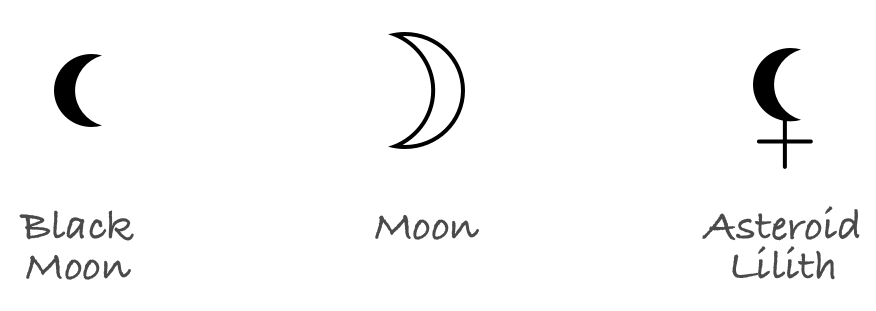
In visual symbolic language, the cross signifies matter. All planets are material objects and they all have a cross as a part of their pictograms (Mars’ cross eventually became an arrow). Same applies to all asteroids that have a cross at the base to highlight the fact that they are rocky formations.
Since the Black Moon lacking any matter, its correct pictogram doesn’t contain a cross. The Black Moon is represented by a reverted, smaller black pictogram of the Moon which makes a perfect symbolic sense.
Now, the Black Moon pictogram with a cross at its base represents an asteroid Lilith that is a completely different astrological entity.
Time Nomad app uses this symbolically correct pictogram of the Black Moon, reserving the crossed version for asteroid Lilith.
Discovering one’s own Alter Ego
What is a good time to look into your hidden self? Obviously the time when the Black Moon is less inconspicuous.
Every time the Moon is on its apogee, which is the name for its maximum distance from the Earth, it is automatically aligned with the Black Moon.
One can’t see the “real” Black Moon with their physical sight but one can feel how the Moon takes on some of the Black Moon’s qualities. Those times are great openings into the “shadow” or Alter Ego of oneself, and they happen quite regularly, once per lunation or every 27.3 days. Observing the Moon’s cycle of apogees opens the door to the new dimension of astrological insights and interpretations.
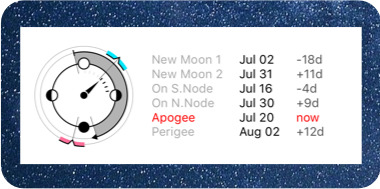
Time Nomad app helps to keep track of the moments when the Moon is on its Apogee and therefore aligned with the Black Moon. The easiest approach is to add a “Chart of Today” widget to the Notification Center (the lock screen) of your iPhone or iPad, this way you don’t even need to open the app. For more detailed information, use the “Dashboard” screen that contains the same widget that can be “tapped” to reveal dates and Zodiacal locations of those events.
Handling your own Black Moon
Discovering one’s “shadow” is perhaps one of the most challenging yet undoubtedly rewarding processes. Use regular passages of the Moon through its apogee to notice and ultimately reveal your unknown self.
Most likely, your Black Moon comes with the both positive and negative influences and traits. That is completely normal, just like any coin has to have two sides to be a coin.
Keep noticing dark patterns that may be preventing your success or could be responsible for unconscious manipulative actions towards others thus darkening your karma and making things different for the future. The Black Moon has a “witchy” side that isn’t likely to play in one’s favour in its disowned condition. There’s a force there, it needs to be objectified and brought to the light of consciousness.
The Black Moon also potentially comes with a package of past traumas that may have been wilfully forgotten, erased from conscious memory. But they haven’t forgotten about us, actively redirecting the circumstances away from fuller and more accomplished lives. It takes a good degree of inner honesty and self-acceptance to successfully deal with your own “shadow” but the promise and the potential are both there, seize them!
18 Comments
Siobhan
Very “illuminating”. 🤣
Diane
Great reading thank you
Michael
I was first introduced to the Black Moon when I received a full reading of my natal chart using the Clairvision Virtual Astrologer. Correspondingly, I felt “removed” from the concept, not quite able to “connect” with it; however, you’ve now made it profoundly easy for me to understand, and I sincerely appreciate it. Thank you.
Nancy
Thanks so much for such a clear explanation of the Black Moon with great details! all the best!
Lynn
Very interesting and helpful. Thank you!
yahbz
I am a Leo Black Moon Ascendant… any questions on how that energy loves to show itself, I am more than happy to be the guinea pig 🙏🏽🙏🏽🙏🏽
Time Nomad
The Black Moon on the ascendant, fascinating! You could be rebellious and desiring for absolute. Perhaps the need for independence. Seeing deeper into other people psyche. A lot depends on other aspects of your chart, how the Black Moon integrates with the rest of planets. Still, it’s a strong influence. The Black Moon is a bit like Pluto, but not quite. You can look into your Pluto and try to discern the difference. That would be a great exercise in deciphering yourself!
Allison currie
Black moon is in Scorpio and so is my moon… any help translating that would be greatly appreciated !! Xoxo
Time Nomad
It’s a kind of “the Black Moon meets Pluto” – you can see it expressing itself in two major areas: sexuality and mysticism/occult/spirituality. Makes you see things others don’t.
Lacey
I have black moon in Gemini. I’m not familiar with the meaning. Translation?
Time Nomad
It doesn’t do much unless it’s aspected to something. With the Black Moon always look at its aspects.
ryan
how do i find the black moon in my chart?
Time Nomad
First, make sure the Black Moon is activated in the app settings (in “Planets & Bodies”). Then in the chart look for an inverted Moon symbol. There’s also a help page in the app (look in the top right corner menu, “Illustrated help”)
wuvlfx
I have a super tight conjunction between Pluto (7♐︎45) and my Black Moon (8♐︎36) with my Moon further ahead at 21♐︎29; these are all in my Eighth house. Would you be able to tell me a bit about this if you’ve the time?
Time Nomad
Well, that’s a fascinating placement, a kind of double Pluto in its own house of sex, death and occult. Basically a very strong independent personality with some deep occult potential. How much that is implemented in life that’s another question but the force is there. Greatly benefits from discernment and exactitude, the Black Moon is good with that.
Mich
I absolutely love this app. How it took me so long to discover it… only the stars know. Get it? 🤪
Anyway, thank you for such a great app. I’m fascinated with sidereal so this app is great much info.
I noticed my black moon is opposing my north Node in 10H Gemini. I get this feeling that I’ll never get to complete what I came here for just because it’s so hidden. Lol My sun (Leo) in 12H squares my black moon as well. Life doesn’t seem hard but I can’t seem to grasp it even though I know there’s something there. Lol
Many thanks of you do provide feedback. 🙏🏻 Can I be a guinea pig? 🤗
Time Nomad
The Black Moon often requires a thorough investigation of your deeper inner self. Planets aligned to the South Node point to the past lives that hold the answer. It’s a case of using regression techniques to look into one’s past to understand one’s present. Astrological chart gives us hints and directions for further investigate but doesn’t necessarily provide the answers.
Claudio Silvaggi
A grackle landed on my mirror and strangely looked straight up spinning his head while looking straight up beak pointing to the Sky above… I looked at the chart of the moment for the location I was in (Fla) and the Black Moon was exactly aligned the Mc (midheaven)… This happened a couple more times… Then the next time the grackle moved position on the mirror did the same… Eris was aligned the Mc… I went outside and talked to the divine feminine about the upcoming phoenix rising on April 14/15th 2023 on 0°Aries and while my eyes were closed a single small cloud came by in a clear blue sky and rained on me for literally seconds I opened my eyes to see the little cloud go by… This is what Black moon does… Deep spiritual Signs… Denis is so awesome to make such a remarkable app and this type of learning… cheers to our bright future as written in the stars… ❤️🙏